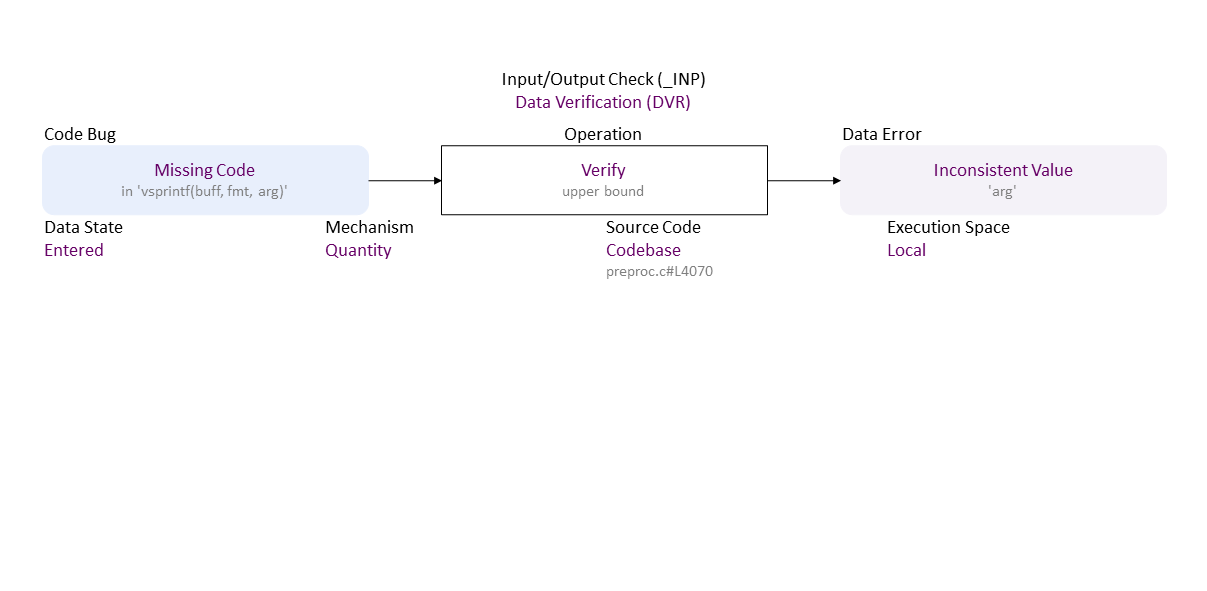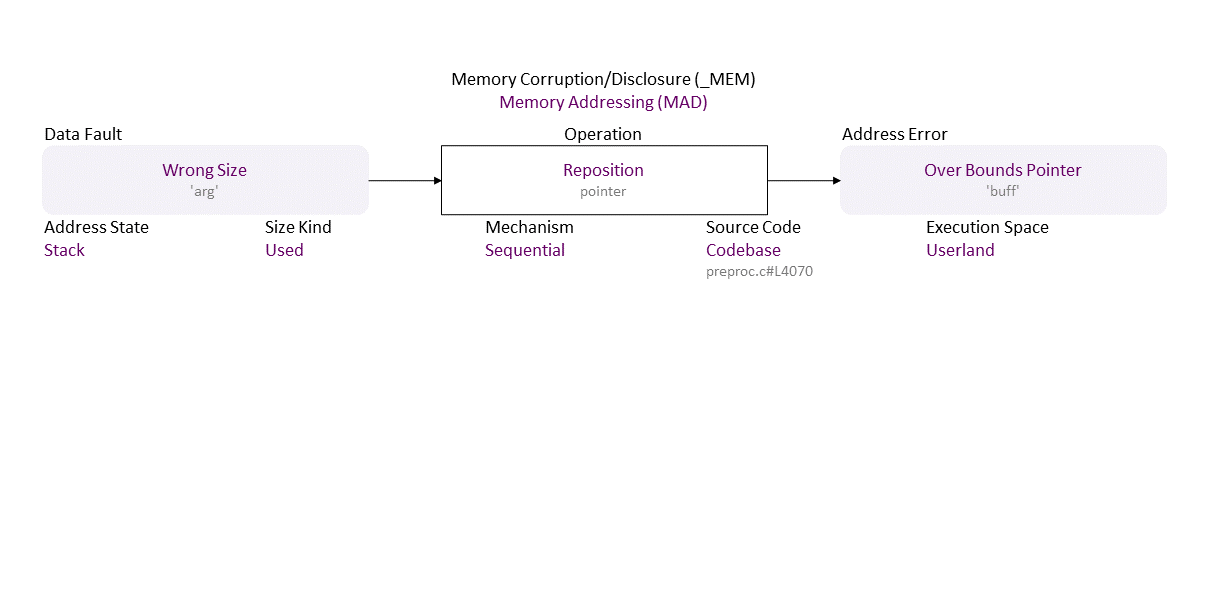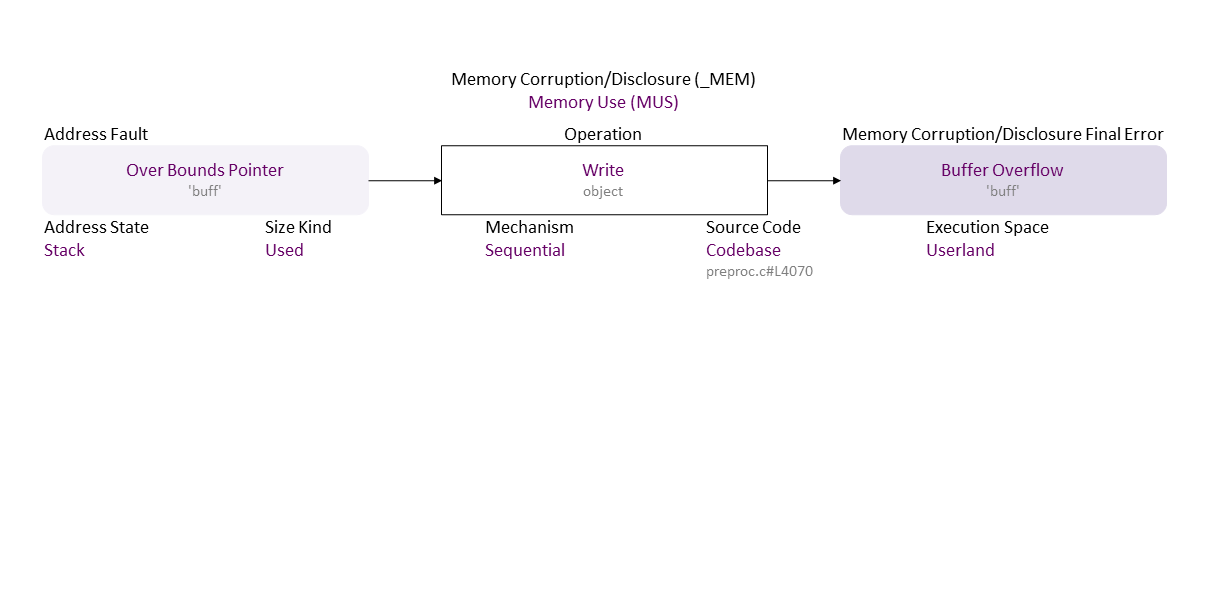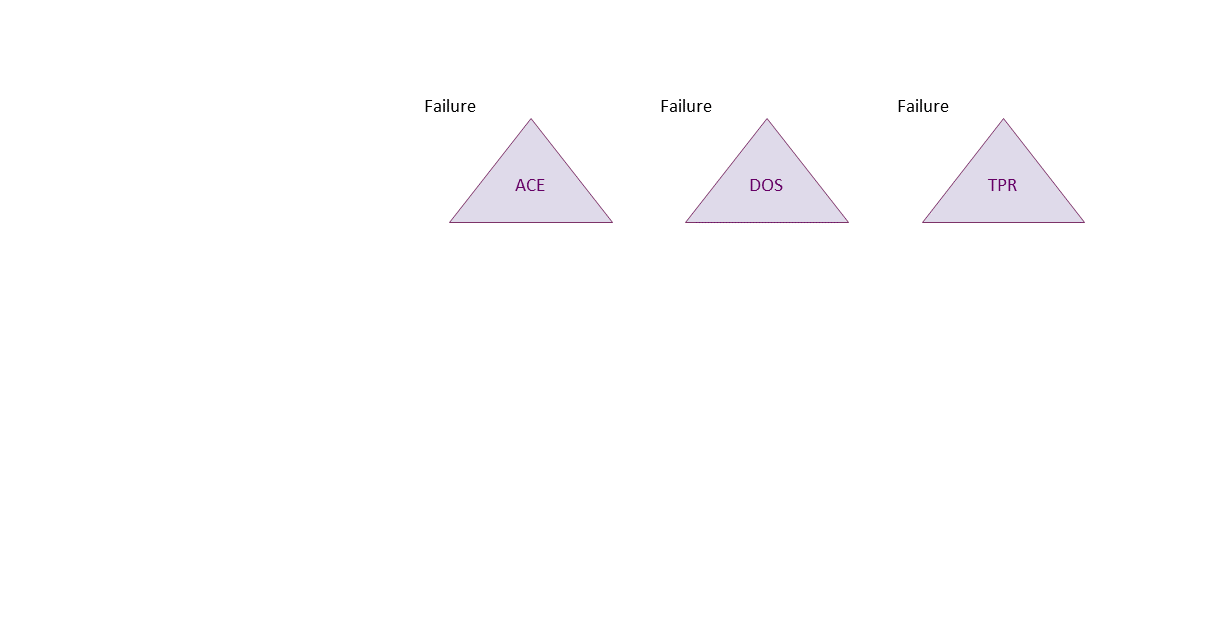BF Specification of CVE-2004-1287 Stack Buffer Overflow in NASM 0.98.38 1.2
-0.png)
Missing verification of 'arg' towards a upper limit leads to use of an inconsistent size for an object, allowing a pointer reposition over its bounds, which, when used in ‘vsprintf()' leads to a stack buffer overflow. If exploited, this can lead to data tampering, denial of service (application crash), or remote code execution.
//generated// Missing Code (in ‘vsprintf(buff, fmt, arg)’) to Quantity Verify upper bound Entered in Codebase (preproc.c#L4070) Local leads to Inconsistent Value (‘arg’)
, which propagates to Wrong Size (‘arg’) Sequential Reposition (pointer) Stack Used Codebase (preproc.c#L4070) in Userland resulting in Over Bounds Pointer (‘buff’)
, which propagates to Over Bounds Pointer (‘buff’) Sequential Write (object) Stack Used Codebase (preproc.c#L4070) in Userland resulting in Buffer Overflow (‘buff’)
. If exploited this can lead to ACE (everything could be lost) or DOS (availability loss) or TPR (integrity loss).
vendor:product: nasm:netwide_assembler |
|
| Class | Definition |
| DVR | Data Verification (DVR) class – Data are verified (semantics check) or corrected (assign, remove) improperly. |
| MAD | Memory Addressing (MAD) class – The pointer to an object is initialized, repositioned, or reassigned to an improper memory address. |
| MUS | Memory Use (MUS) class – An object is initialized, read, written, or cleared improperly. |
| Operation | Definition |
| Verify | Verify operation – Check data semantics (proper value/meaning) in order to accept (and possibly correct) or reject it. |
| Reposition | Reposition operation – Change the pointer to another position inside its object. |
| Write | Write operation – Change the data value of an object to another meaningful value. |
| Cause/Consequence | Definition |
| Code Bug | Code Bug type – Defect in the implementation of the operation – proper operands over an improper operation. A first cause for the chain of weaknesses underlying a software security vulnerability. Must be fixed to resolve the vulnerability. |
| Missing Code | Missing Code bug - The operation is entirely absent. |
| Data Error/Fault | Data Fault/Error type – The object data has harmed semantics or inconsistent or wrong value. |
| Inconsistent Value | Inconsistent Value fault/error – Data value does not correspond to the value of a related data (e.g., inconstancy between the value of a size variable and the actual buffer size). |
| Wrong Size | Wrong Size fault/error – The value used as size does not match the actual size of the object (e.g., to restrict pointer repositioning or index increment/decrement in a repetition statement). |
| Address Error/Fault | Address Fault/Error type – The object address in use is wrong. |
| Over Bounds Pointer | Over Bounds Pointer fault/error – Holds an address above the upper boundary of its object. |
| Memory Corruption/Disclosure Final Error | Memory Corruption/Disclosure exploitable error type – An exploitable or undefined system behavior caused by memory addressing, allocation, use, and deallocation bugs. |
| Buffer Overflow | Buffer Overflow exploitable error – Writing above the upper bound of an object – aka Buffer Over-Write. |
| Operation Attribute | Definition |
| Mechanism | Mechanism operation attribute type – Shows how the buggy/faulty operation code is performed. |
| Quantity | Quantity operation attribute – The operation checks data for a specific measurable value (e.g., size, time, rate, frequency). |
| Sequential | Sequential operation attribute – The operation is via iterating over the object elements. |
| Source Code | Source Code operation attribute type – Shows where the operation with the bug or a faulty operand is in the program – in what kind of software. |
| Codebase | Codebase operation attribute – The operation is in the programmer's code - in the application itself. |
| Execution Space | Execution Space operation attribute type – Shows where the buggy/faulty operation code is running or with what privilege level. |
| Local | Local operation attribute – The bugged code runs in an environment with access control policy with limited (local user) permission. |
| Userland | Userland operation attribute – The bugged code runs in an environment with privilege levels, but in unprivileged mode (e.g., ring 3 in x86 architecture). |
| Operand Attribute | Definition |
| Data State | Data State operand attribute type operand attribute – Shows where the data come from. |
| Entered | Entered operand attribute – Data are from a user via a user interface (e.g., input field of a dialog or a command prompt). |
| Address State | Address State operand attribute type - State operand attribute type – Shows where the address is in the memory layout. |
| Stack | Stack operand attribute – The object is a non-static local variable (defined in a function, a passed parameter, or a function return address). |
| Size Kind | Size Kind operand attribute type – Shows what the limit for traversal of the object is. |
| Used | Used operand attribute – A supplied size for an object. |



